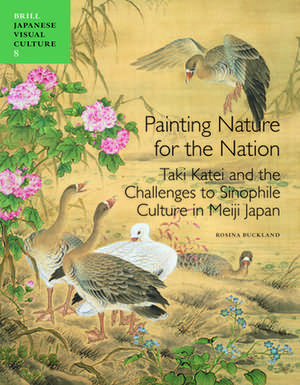Painting Nature for the Nation: Taki Katei and the Challenges to Sinophile Culture in Meiji Japan: Japanese Visual Culture, cartea 8
Autor Rosina Bucklanden Limba Engleză Hardback – 18 dec 2012
Din seria Japanese Visual Culture
- 18%
 Preț: 1000.74 lei
Preț: 1000.74 lei - 18%
 Preț: 710.71 lei
Preț: 710.71 lei - 18%
 Preț: 680.55 lei
Preț: 680.55 lei - 15%
 Preț: 399.81 lei
Preț: 399.81 lei - 18%
 Preț: 642.12 lei
Preț: 642.12 lei - 18%
 Preț: 641.33 lei
Preț: 641.33 lei - 18%
 Preț: 724.72 lei
Preț: 724.72 lei - 18%
 Preț: 581.72 lei
Preț: 581.72 lei - 18%
 Preț: 588.90 lei
Preț: 588.90 lei - 18%
 Preț: 631.85 lei
Preț: 631.85 lei - 18%
 Preț: 677.48 lei
Preț: 677.48 lei - 18%
 Preț: 704.36 lei
Preț: 704.36 lei - 18%
 Preț: 654.93 lei
Preț: 654.93 lei - 18%
 Preț: 591.39 lei
Preț: 591.39 lei - 18%
 Preț: 613.52 lei
Preț: 613.52 lei - 18%
 Preț: 840.36 lei
Preț: 840.36 lei - 18%
 Preț: 601.01 lei
Preț: 601.01 lei - 18%
 Preț: 599.08 lei
Preț: 599.08 lei - 18%
 Preț: 597.91 lei
Preț: 597.91 lei
Preț: 601.24 lei
Preț vechi: 733.23 lei
-18% Nou
Puncte Express: 902
Preț estimativ în valută:
115.04€ • 120.55$ • 95.11£
115.04€ • 120.55$ • 95.11£
Carte indisponibilă temporar
Doresc să fiu notificat când acest titlu va fi disponibil:
Se trimite...
Preluare comenzi: 021 569.72.76
Specificații
ISBN-13: 9789004233553
ISBN-10: 9004233555
Pagini: 264
Dimensiuni: 196 x 251 x 23 mm
Greutate: 1.08 kg
Editura: Brill
Colecția Brill
Seria Japanese Visual Culture
ISBN-10: 9004233555
Pagini: 264
Dimensiuni: 196 x 251 x 23 mm
Greutate: 1.08 kg
Editura: Brill
Colecția Brill
Seria Japanese Visual Culture
Notă biografică
Rosina Buckland, Ph.D (Institute of Fine Arts, New York University, 2008) is Senior
Curator for Japanese Collections at the National Museum of Scotland. Her most recent publication is Shunga: Erotic Art in Japan (2010).
Curator for Japanese Collections at the National Museum of Scotland. Her most recent publication is Shunga: Erotic Art in Japan (2010).
Recenzii
Buckland’s study is extremely comprehensive; she has apparently left no stone unturned throughout Japan and the United Kingdom in tracking down Katei’s extant works, many of which are reproduced in full color and with considerable attention to detail and technique. […] Given Katei’s prominence, this is a significant contribution and makes the book a valuable resource. […] Buckland’s study is accessible and easy to read, enlivened with amusing anecdotes about Katei himself, especially his skill at swordsmanship (e.g. p.45). In making Katei and his works accessible, and in its focus on the role of painting in Meiji nation-building, the study will interest art and cultural historians and non-specialist readers alike.
Robert Tuck in Japan Review Nr. 28 (2015), pp. 241-243.
Robert Tuck in Japan Review Nr. 28 (2015), pp. 241-243.
